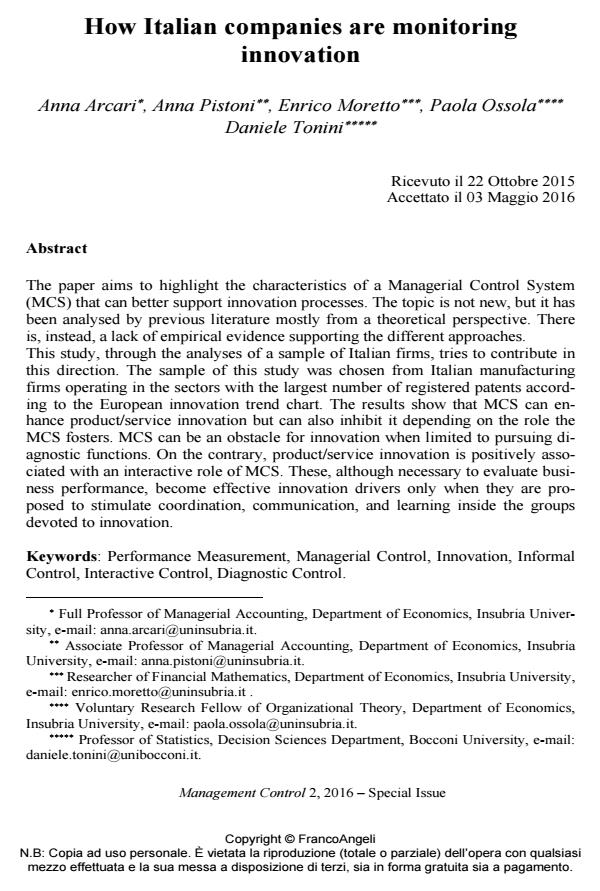How Italian companies are monitoring innovation
Journal title MANAGEMENT CONTROL
Author/s Anna Arcari, Anna Pistoni, Enrico Moretto, Paolo Ossola, Daniele Tonini
Publishing Year 2016 Issue 2016/2
Language English Pages 23 P. 143-165 File size 279 KB
DOI 10.3280/MACO2016-002007
DOI is like a bar code for intellectual property: to have more infomation
click here
Below, you can see the article first page
If you want to buy this article in PDF format, you can do it, following the instructions to buy download credits

FrancoAngeli is member of Publishers International Linking Association, Inc (PILA), a not-for-profit association which run the CrossRef service enabling links to and from online scholarly content.
The paper aims to highlight the characteristics of a Managerial Control System (MCS) that can better support innovation processes. The topic is not new, but it has been analysed by previous literature mostly from a theoretical perspective. There is, instead, a lack of empirical evidence supporting the different approaches. This study, through the analyses of a sample of Italian firms, tries to contribute in this direction. The sample of this study was chosen from Italian manufacturing firms operating in the sectors with the largest number of registered patents according to the European innovation trend chart. The results show that MCS can enhance product/service innovation but can also inhibit it depending on the role the MCS fosters. MCS can be an obstacle for innovation when limited to pursuing diagnostic functions. On the contrary, product/service innovation is positively associated with an interactive role of MCS. These, although necessary to evaluate business performance, become effective innovation drivers only when they are proposed to stimulate coordination, communication, and learning inside the groups devoted to innovation.
Keywords: Performance Measurement, Managerial Control, Innovation, Informal Control, Interactive Control, Diagnostic Control
- Preventing crises and managing turnaround processes in SMEs The role of economic measurement tools Anna Maria Arcari, in MANAGEMENT CONTROL 3/2018 pp.131
DOI: 10.3280/MACO2018-003007 - High Performance Through Innovation Process Management in SMEs. Evidence from the Italian wine sector Simona Alfiero, Laura Broccardo, Massimo Cane, Alfredo Esposito, in MANAGEMENT CONTROL 3/2018 pp.87
DOI: 10.3280/MACO2018-003005 - Management accounting systems in venture capital-backed start-up companies Simone Aresu, Luigi Rombi, Andrea Cardia, in MANAGEMENT CONTROL 3/2019 pp.35
DOI: 10.3280/MACO2019-003003
Anna Arcari, Anna Pistoni, Enrico Moretto, Paolo Ossola, Daniele Tonini, How Italian companies are monitoring innovation in "MANAGEMENT CONTROL" 2/2016, pp 143-165, DOI: 10.3280/MACO2016-002007